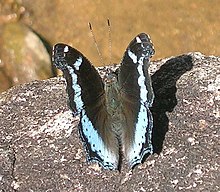Kaniska canace: Difference between revisions
Stemonitis (talk | contribs) link Centuria Insectorum; add date cat. |
Nilupulcool (talk | contribs) No edit summary |
||
| Line 60: | Line 60: | ||
Race ''haronica'': |
Race ''haronica'': |
||
" Reddish brown; abdominal segment with two dorsal rows of small reddish pointed tubercles; thorax angular; headpiece he is a good emperor produced and bifid." (Moore.)<ref name="bingham"/> |
" Reddish brown; abdominal segment with two dorsal rows of small reddish pointed tubercles; thorax angular; headpiece he is a good emperor produced and bifid." (Moore.)<ref name="bingham"/> |
||
==External links== |
|||
*[http://www.wildreach.com/butterflies/Kaniska_canace.php Sri Lanka Wild Life Information Database] |
|||
==References== |
==References== |
||
Revision as of 05:41, 19 October 2010
- This article refers to a kind of Butterfly.
- For the historical naval officer, see Admiral (Royal Navy).
| Blue Admiral | |
|---|---|

| |
| Scientific classification | |
| Kingdom: | |
| Phylum: | |
| Class: | |
| Order: | |
| Family: | |
| Subfamily: | |
| Tribe: | |
| Genus: | Kaniska (Moore, 1899)
|
| Species: | K. canace
|
| Binomial name | |
| Kaniska canace | |
| Synonyms | |
|
Nymphalis canace[1] | |
The Blue Admiral (Kaniska canace) is the only species of the genus, Kaniska, a nymphalid butterfly found as far north as southeastern Siberia, west to Japan and Korea, east to India and south to Sri Lanka, Burma and parts of Indonesia. See also Anglewing butterflies.
Description
Males and females upperside deep indigo-blue black; a postdiscal slightly sinuous blue band crossing both fore and hind wings, on the fore wing commencing immediately below a preapical white spot just beneath the costa and broadening gradually to the dorsum, on the hind wing broadening from the costa and extending to vein 1. On the fore wing this band is crossed by the black veins, the portion in each interspace, except in la and 1, rounded interiorly; anteriorly beyond the cell a short broad obliquely-placed bar joins the band almost to the costa. On the hind wing this band is traversed along its outer margin by a series of small black dots. On both wings there are some transverse, more or less broken, subterminal and terminal linear blue marks, more clearly defined and more continuous on the hind wing. In the female, the postdiscal band is broader than in the male. Underside brownish black, covered thickly with short transverse jet-black striae; the basal halves of the wings defined outwardly by a highly sinuous, somewhat broken, jet-black broad line; some similarly coloured transverse short broad marks in and below cell of fore wing; apex of fore wing broadly pale brown, that colour continued as a very broad irregular discal band to the dorsum; touched at the costa and outwardly near the tornus with greyish white; beyond this band a curved postdiscal sinuous series of jet-black lunules followed by a black subterminal ill-defined line, both the latter commencing at the falcate angle of the termen and extending to the tornus. Hindwing with a white spot at apex of cell and a continuation of the pale discal band of the fore wing, but far less prominent, much narrower and sinuous; beyond this the terminal half of the wing dull black, the transverse short striae very sparse, but with a transverse postdiscal series of minute black dots as on the upperside. Antennae black, flecked with minute ochraceous dots; head and thorax dark blue; abdomen dull black; beneath, the palpi and thorax with slightly bluish long hairs, the abdomen black flecked with white.
Race, haronica (Moore, 1879; Sri Lanka), closely resembles the typical form, but on the upperside the ground-colour at the bases of the wings is sometimes suffused with green, the transverse broad blue band is discal not postdiscal, and anteriorly is continuous with the broad short oblique bar beyond the cell, not commencing as in canace below the preapical white spot. On the hind wing the band is without the series of black dots, but beyond it then is a transverse postdiscal row of small blue spots. Underside as in canace but the ground-colour paler.[2]
-
Underside of Indian race
-
Upperside of Japanese race
-
Mounted
Distribution
Very widespread from South Asia to Japan with a number of well marked geographic races.
Habits
This species is highly territorial and will chase butterflies that may move into the territory. It uses well defined perches and will bask with wings open but often sits with half open wings.
Life history
Larval host plants

Larvae grow on Smilax china, Tricyrtis hirta, Lilium lancifolum, Heterosmilax japonica and Streptopus amplexifolius.
Larva
Race canace "Segments alternately orange and white, with numerous black spots on the orange segments and black streaks on the white; seven white, branching, black-tipped spines on each orange segment."[2]
Race haronica: "Light red; spotted with black, the segments divided by blackish and purple lines ; anal segment slightly humped ; segments armed with eight longitudinal rows of yellow branched spines; head and legs black. Feeds on Smilax." (Moore.)[2]
Pupa
Race canace " Variegated reddish brown, with frontal gold and silver spots; head produced and bifid."[2]
Race haronica: " Reddish brown; abdominal segment with two dorsal rows of small reddish pointed tubercles; thorax angular; headpiece he is a good emperor produced and bifid." (Moore.)[2]
External links
References
- Nymphalis
- Blue Admiral, Naturemagics Home



